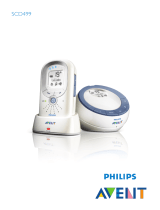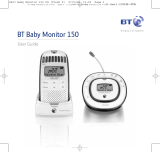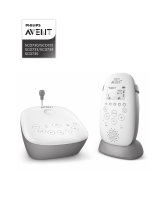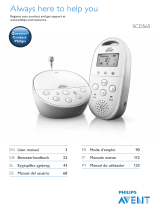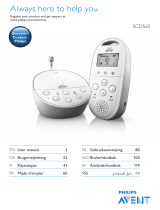
Note: If the rechargeable battery pack is completely empty, the parent unit automatically switches off
and loses contact with the baby unit.
1 Remove the lid of the compartment for the rechargeable battery pack (Fig. 6).
2 Insert the rechargeable battery pack (Fig. 7).
3 Reattach the lid (Fig. 8).
4 Insert the small appliance plug into the charger, put the adapter in a wall socket and place the
parent unit in the charger (Fig. 9).
, The charging light on the charger goes on.
, The display shows a charging battery symbol to indicate that the parent unit is charging.
5 Leave the parent unit in the charger until the battery pack is fully charged.
, During charging, the charging light on the charger lights up continuously.
, When the battery pack is fully charged, the display of the parent unit shows a full battery
symbol T.
- When you charge the parent unit for the rst time or after a long period of disuse, switch it
off and let it charge continuously for at least 10 hours.
- Charging normally takes 4 hours, but it takes longer when the parent unit is switched on while
charging. To keep the charging time as short as possible, switch off the parent unit during
charging.
- When the battery pack is fully charged, the parent unit can be used cordlessly for at least 24
hours.
Note: When the parent unit is charged for the rst time, the operating time is less than 24 hours. The
battery pack only reaches its full capacity after you have charged and discharged it four times.
Note: When the parent unit is not in the charger, the battery pack gradually discharges, even when the
parent unit is switched off.
Using the appliance
1 Place the parent unit and the baby unit in the same room to test the connection (Fig. 10).
Make sure the baby unit is at least 1 metre/3 feet away from the parent unit.
2 Press and hold the on/off button 3 on the baby unit until the green power-on light goes
on. (Fig. 11)
Note: The power-on light always lights up green, even when there is no connection with the parent unit.
, The nightlight lights up briey and then fades out again.
, The display lights up and the battery symbol appears on the display (Fig. 12).
, After 2 seconds the temperature and humidity values are shown on the display (Fig. 13).
3 Press and hold the on/off button 3 on the parent unit until the sound level lights light up
briey. (Fig. 14)
, The display goes on and the battery symbol appears on the display (Fig. 15).
, The LINK light ashes red and the message ‘Searching’ appears on the display. (Fig. 16)
, The LINK light on the parent unit turns green and lights up continuously when a connection
has been established between the baby unit and parent unit. The message ‘Linked’ appears on
the display. (Fig. 17)
, After 2 seconds the message ‘Linked’ disappears and the temperature and humidity values
are shown on the display. (Fig. 18)
, The rst time you switch on the parent unit, the message ‘Language’ appears on the display.
Select the desired language (see chapter ‘Menu options, section ‘Setting display
language’). (Fig. 19)
ENGLISH 9















